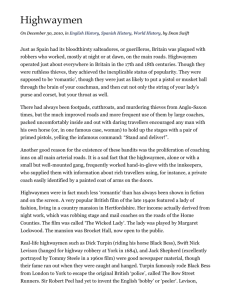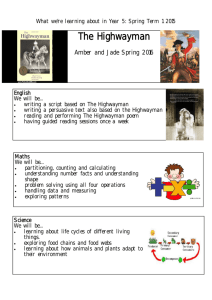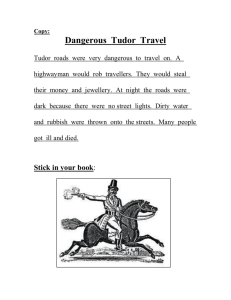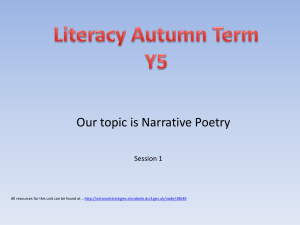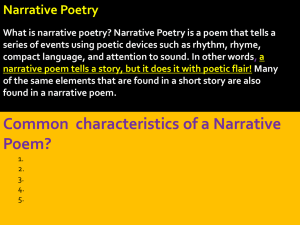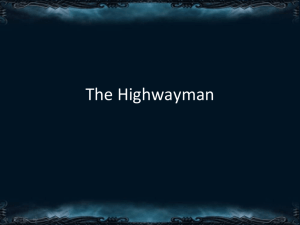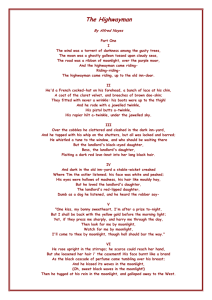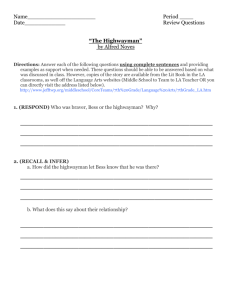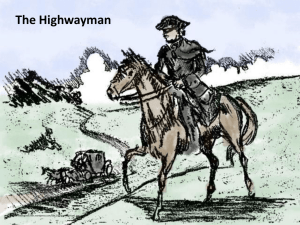Highwaymen Information Gap - Collaborative Learning Project
advertisement
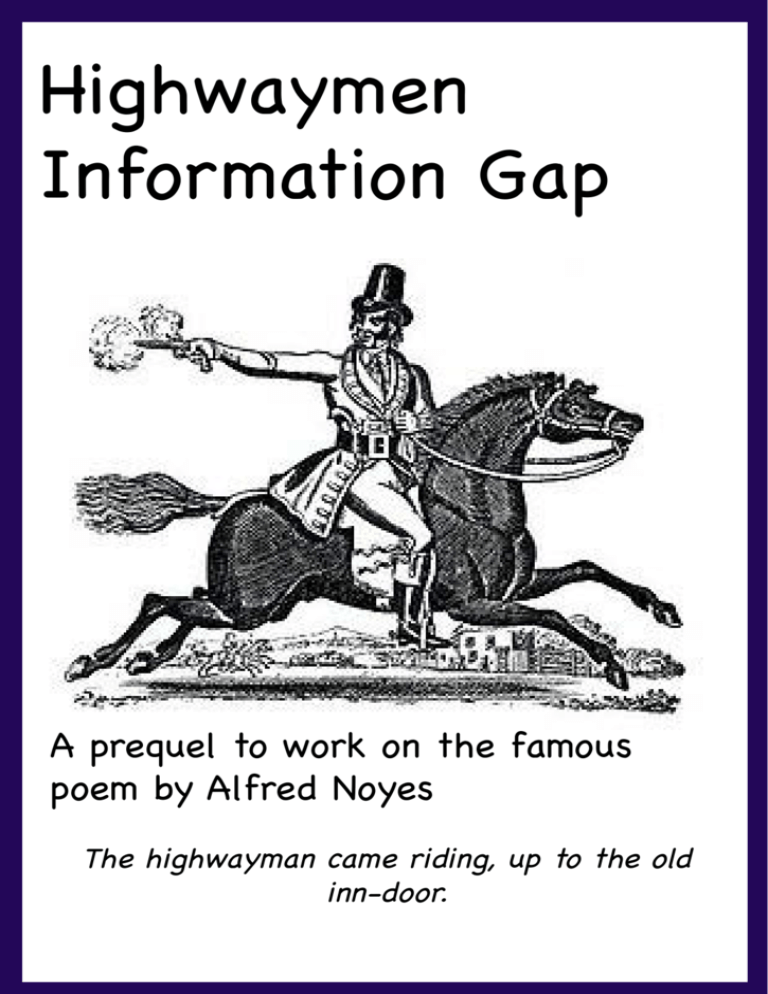
Highwaymen Information Gap A prequel to work on the famous poem by Alfred Noyes The highwayman came riding, up to the old inn-door. Highwaymen THE wind was a torrent of darkness among the gusty trees, The moon was a ghostly galleon tossed upon cloudy seas, The road was a ribbon of moonlight over the purple moor, And the highwayman came riding — Riding — riding — The highwayman came riding, up to the old inn-door. This information gap activity developed by Judith Evans is designed as a prequel to the study of the Alfred Noyes poem. We discovered many children who needed beaming up on the facts before they were able to make sense of the poem. This information gap uses the same format as the Polar Bear activity which you can find in the biology section of the website and can easily be adapted to any other topic that needs clarification through collaborative discussion. Webaddress: www.collaborativelearning.org/highwaymen.pdf Last updated 16th January 2016 COLLABORATIVE LEARNING PROJECT Project Director: Stuart Scott We support a network of teaching professionals to develop and disseminate accessible talk-for-learning activities in all subject areas and for all ages. 17, Barford Street, Islington, London N1 0QB UK Phone: 0044 (0)20 7226 8885 Website: http://www.collaborativelearning.org BRIEF SUMMARY OF BASIC PRINCIPLES BEHIND OUR TEACHING ACTIVITIES: The project is a teacher network, and a non-profit making educational trust. Our main aim is to develop and disseminate classroom tested examples of effective group strategies that promote talk across all phases and subjects. We hope they will inspire you to develop and use similar strategies in other topics and curriculum areas. We want to encourage you to change them and adapt them to your classroom and students. We run teacher workshops, swapshops and conferences throughout the European Union. The project posts online many activities in all subject areas. An online newsletter is also updated regularly. *These activities are influenced by current thinking about the role of language in learning. They are designed to help children learn through talk and active learning in small groups. They work best in non selective classes where children in need of language or learning support are integrated. They are well suited for the development of oracy. They provide teachers opportunities for assessment of talk. *They support differentiation by placing a high value on what children can offer to each other on a particular topic, and also give children the chance to respect each other’s views and formulate shared opinions which they can disseminate to peers. By helping them to take ideas and abstract concepts, discuss, paraphrase and move them about physically, they help to develop thinking skills. *They give children the opportunity to participate in their own words and language in their own time without pressure. Many activities can be tried out in pupils’ first languages and afterwards in English. A growing number of activities are available in more than one language, not translated, but mixed, so that you may need more than one language to complete the activity. *They encourage study skills in context, and should therefore be used with a range of appropriate information books which are preferably within reach in the classroom. *They are generally adaptable over a wide age range because children can bring their own knowledge to an activity and refer to books at an appropriate level. The activities work like catalysts. *All project activities were planned and developed by teachers working together, and the main reason they are disseminated is to encourage teachers to work more effectively with each other inside and outside the classroom. They have made it possible for mainstream and language and learning support teachers to share an equal role in curriculum delivery. They should be adapted to local conditions. In order to help us keep pace with curriculum changes, please send any new or revised activities back to the project, so that we can add them to our lists of materials. Highwaymen Text A Highwaymen were robbers who were active in England from the mid 1600’s to the early 1800’s. 90% of people stayed their whole lives in the place where they were born. Travel was very tricky as the roads were very bad. Stage coaches like the one in the picture would carry four or five passengers between towns. It took 12 days to get from London to Edinburgh. The coach would be pulled by horses. The coaches had to stop often to rest and change the horses and give them food. The Duke’s Head in Wallington is a famous coaching inn. Only rich people could afford to take a coach, the passengers would dread hearing the cry of “Stand and deliver!” because it meant they were about to be robbed of their valuables. There was no national organised police force in those days, but most highwaymen were caught in the end, some by soldiers. Highwaymen were punished harshly when they were caught. They were usually hung and their corpses were displayed to warn other people not to take up this crime. Turnpikes were introduced on the roads which meant people kept an eye on what was happening so it was harder to escape. Highwaymen Text B Highwaymen were robbers. The first report of a highwayman was in the 1650’s and the last report was in 1830. They would ride up to a carriage and threaten the passengers demanding “Your money or your life!” The passengers usually gave away their money and jewellery rather than be shot. Then the Highwayman would ride off very fast. The coaches could not travel fast enough to catch up. In London Shooter’s Hill was a place with many Highwaymen as you can tell from the name. Finchley Common was also very dangerous. The highwaymen were often famous, there were songs and stories about them. A very famous Highway robber was Cutpurse Moll, who was a woman. What did Highwaymen do? Highwaymen were active from _____ to __________. How were they punished? Where were the worst places for Highwaymen in London? 1._____________ ______________ What did they say? 2_____________ Stand and _____________. ______________ Your __________ or your _____. Choose the right answer Choose the right answer: Highwaymen were always male. Highwaymen usually stole • horses • yes • money • no • clothing How long did it take to get from London to Edinburgh? Were these things around in the 1700’s? √ or x • police roads • soldiers trains • coach passengers policemen What were Coaching inns? __________________ __________________ Who caught the highwaymen? post telephones cameras cars How did people travel around the country in the 1700’s ?
